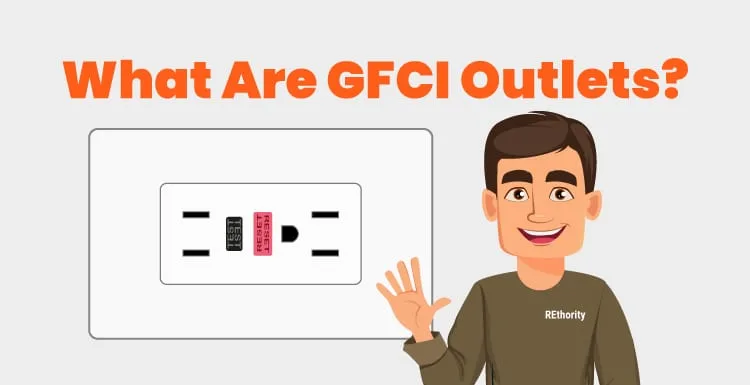Installing or having trouble with a GFCI outlet in your home?
Use our in-depth guide to learn about these safety devices and how to identify, install, and troubleshoot common problems.
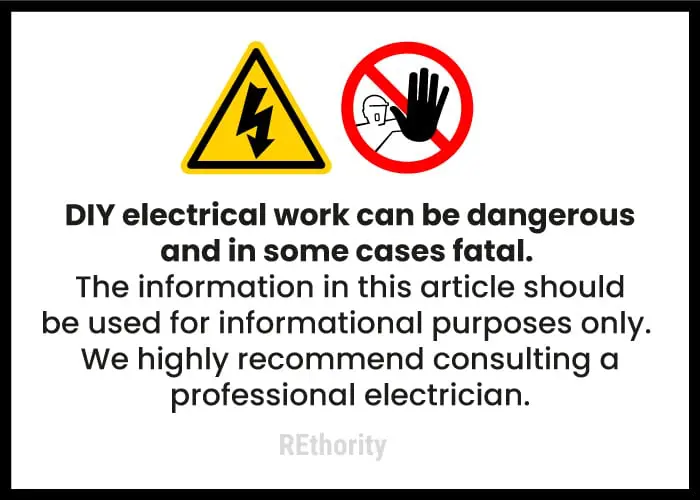
Ground-Fault Circuit Interrupter (GFCI) outlets are electrical safety devices required in U.S. homes and buildings. You can easily tell the difference between these and standard outlets.
GFCI outlets are three-prong outlets with a special distinction: two buttons in the middle of the outlet. These are the Test and Reset buttons, and they’re usually black and red.
You’ll typically find GFCI outlets in your bathroom, kitchen, and laundry rooms. You may also have them throughout your home.
Like smoke detectors, these are household safety devices that you should become familiar with and understand how to use and test. GFCI outlets serve an important purpose in homes and businesses.
This guide will cover what GFCI outlets are for, the related electrical code requirements, how to install them, what to do when they trip, how much they cost, and more.
What Is a GFCI Outlet?
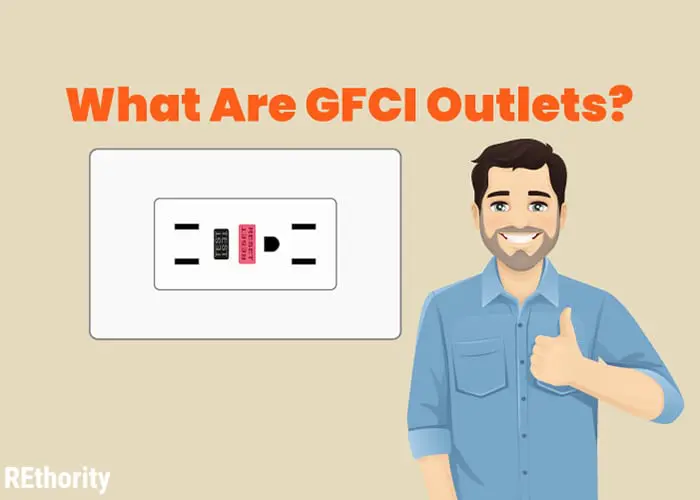
GFCI outlets, or ground-fault circuit interrupters, are sometimes called GFIs. These are electrical safety devices that are installed in electrical outlets.
They are wired to monitor and modulate an electrical current through the outlet. GFCIs are always 3-prong outlets. The slightly larger slot on the left is the neutral slot.
The smaller slot on the right is the hot or live slot, and the round hole underneath them is the ground. We’ll talk more about what this means in the next section.
GFCI outlets today (and since 2015) are self-testing, or offer the ability to test and reset directly from the outlet.
These are the two buttons you’ll see in the center of these outlets. They’re usually red and black, but sometimes they’re the same color as the outlet itself.
All electrical outlets on the same circuit as a GFCI outlet (those wired further away from the circuit breaker on the same circuit) benefit from their ground fault protection.
This includes any kitchen appliances that are plugged into standard outlets. For example, in my home, a tripped GFCI outlet in my bathroom will also trip outlets in the kitchen.
That said, if you lose power to one of your outlets, go to the closest water source (sinks, water heaters, etc.) and reset the outlet. That’ll likely do the trick.
How Does a GFCI Outlet Work?
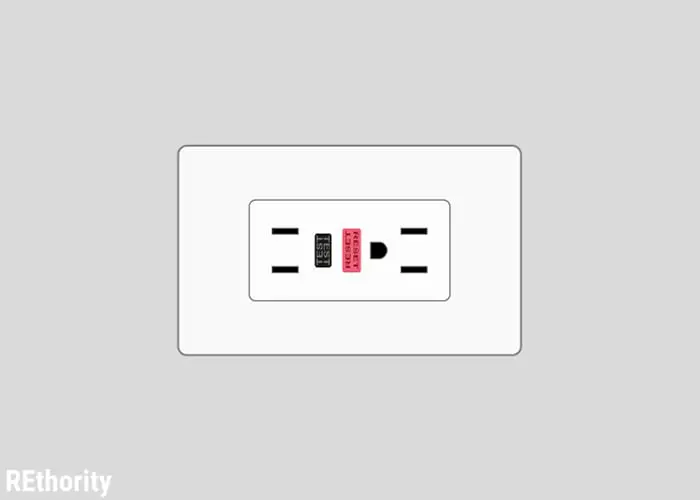
In a normal electrical circuit, current travels from the hot or live wire (smaller right slot on the outlet) to the neutral wire (larger left slot on the outlet).
If any current returns to the ground wire (small round hole on the outlet) instead of the neutral wire, it causes a ground fault. This is what triggers the GFCI outlet to cut the flow of electricity.
When a ground fault occurs, a GFCI outlet automatically cuts the power to the outlet to prevent shock, fire, or further damage.
Ground faults occur (and GFCI outlets cut the power) when:
- Electrical devices operate in damp or wet conditions
- Electrical devices have frayed or damaged wiring or cords
- Appliances or devices plugged in are leaking or operating incorrectly
- Appliances or devices plugged in are overheating
What GFCI outlets do not do is offer protection against overloaded and short circuits. This is what makes them different from circuit breakers.
Circuit breakers and GFCI outlets are like partners in electrical safety. GFCI outlets are the first line of defense. They handle ground faults and electrical currents that are too low to actually trip a circuit breaker.
The Benefit
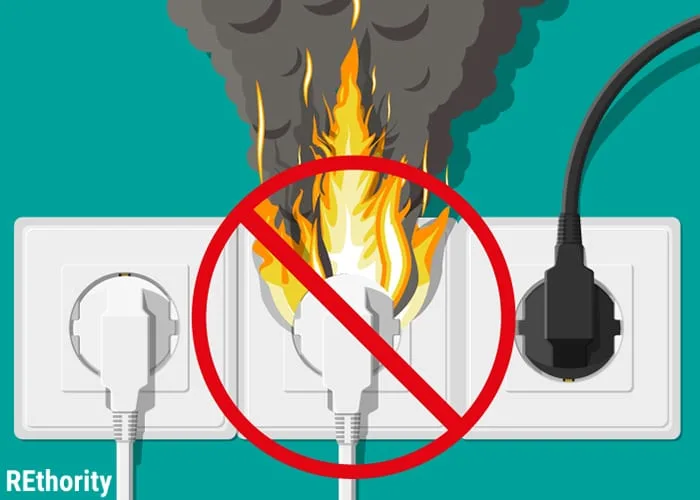
Circuit breakers handle dangerous short circuits and overloads. With both devices in play, a home or business has considerably less risk of electrical shock or fire.
The GFCI/GFI senses the flow of current in a specific circuit to track if it rises or falls (which would be a safety risk).
If any change in current indicates a ground fault has occurred, the GFCI stops the flow of electrical current to prevent shocks or electrical fires. Remember, ground faults can be caused by anything from frayed wires to a power surge.
Normally, the electrical current that flows out of the hot wire (live wire) will loop back to the neutral wire to close the circuit and keep electricity from flowing into unwanted paths.
If it does not—say, if your hand mixer falls into the full kitchen sink while plugged in—the current changes, and the GFCI outlet senses it. It cuts the current immediately.
Example
Here’s an illustrative example. Imagine you’re observing a venomous snake in a glass tank at a zoo.
You can be near it and look at it closely with the protection of the glass tank separating you, but the moment the glass breaks or the snake finds a way out, you’re in danger.
A normal electrical circuit should be closed like that glass tank, with current from the hot wire moving to the neutral wire in a solid loop.
GFCI outlet wiring is like the zoo worker who immediately catches the escaped snake (dangerous electrical current) to prevent it from harming anyone should the glass tank (circuit) open.
Where Should GFCI Outlets Be Installed?
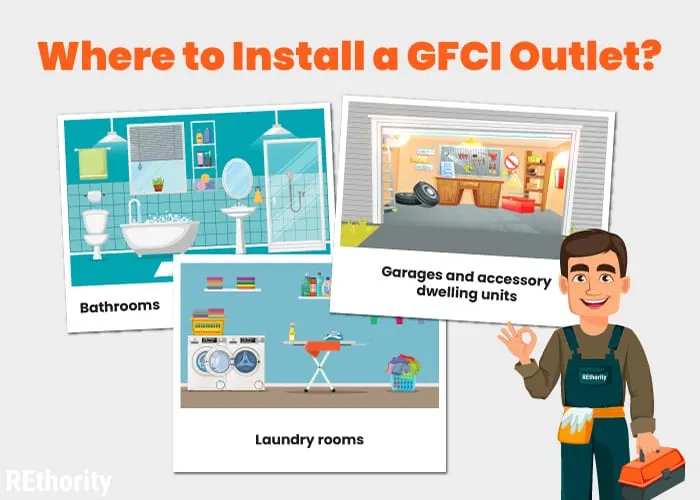
GFCI outlets aren’t required in every room of your home, but the National Electrical Code (NEC) does have some GFCI outlet requirements.
GFCIs are required in any household area that is damp or wet. This means bathrooms, kitchens, laundry rooms, and pool houses must have a GFCI outlet.
Garages, accessory dwelling units, crawl spaces, and basements are also included in the requirements. All single-phase 125-volt outlets up to 250-volt outlets have to have GFCI protection, according to the NEC.
Where to Install One
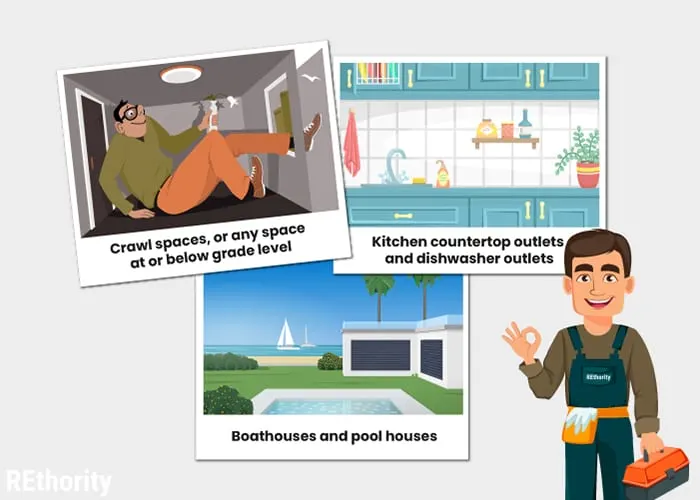
Here’s a complete list of where GFCI outlets must be installed:
- Garages and accessory dwelling units (ADUs) used for storage or work
- Bathrooms
- Laundry rooms
- Outdoors: Outlets under eaves of roofs, at multifamily dwellings with individual entrances at grade level, and any outdoor outlet installed 150-volts to ground or less, and up to 50 amps of current
- Finished or unfinished basements
- Outlets within 6 feet of a sink
- Crawl spaces, or any space at or below grade level
- Kitchen countertop outlets and dishwasher outlets
- Boathouses and pool houses
GFCI outlets’ built-in protection doesn’t just cover one outlet. It protects all properly wired outlets located “downstream,” or further down the circuit away from the circuit breaker. One GFCI outlet per room does the same job as multiple GFCIs in every room.
How to Install a GFCI Outlet

Installing GFCI outlets is relatively simple for an experienced electrician, but it can be somewhat complicated and potentially dangerous for an inexperienced person.
This is the process of how to install GFCI outlets. The first thing you want to do is understand where GFCI outlets are required according to national and local building codes.
The areas listed above are a good starting point, but you’ll need to check with an electrician or consult your local codes to be sure.
To install a GFCI outlet, a licensed electrician will follow these general steps.
- Turn off the power at the circuit breaker to stop all electrical current flow in the house.
- Use a screwdriver to remove the wall plate of the outlet you’ll be replacing with a GFCI outlet. Use a tester to be sure that the power is off.
- Remove the existing outlet and pull it away from the circuit box. You’ll see two or more wires of different colors (black, white, and green). Do not allow the wires to touch.
- Turn the switch on, and use the tester to see which wires are carrying current. Mark them with a permanent marker, and turn the switch off again.
- The GFCI outlet has two sets of wires: line and load wires. Line wires bring the incoming power to the outlet, and load wires send the electric current to other outlets while protecting against shock. Connect the black power wire to the line wire set and the white wire to the load wire set. Use a wire nut to tighten these into place and wrap them with electrical tape.
- Finally, connect the ground wire to the green screw on the GFCI plug. Place the plug back in the circuit box and cover it with the wall plate.
Note: If you’re wondering how to install a GFCI outlet with four wires, you should call an electrician for help. One pair is the line, and the other pair is the load.
For safety purposes, only an electrician should attempt to identify which is which. If you make a mistake in identifying them, the outlet could still receive power even if the GFCI is tripped. This could prove fatal or very dangerous.
When Should I Install a GFCI Outlet Outdoors?
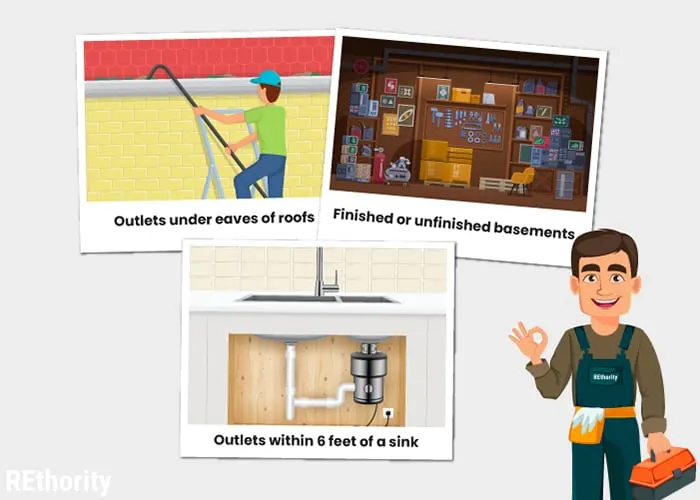
You are required to install GFCI outlets outdoors in a few circumstances. Any outlets located under the eaves of roofs, at multifamily houses with their own separate entrances at ground level or lower, or that are 150 volts to ground or less (up to 50 amps) must be GFCI outlets, according to the NEC.
Outdoor GFCI outlets must meet the following requirements for safety:
- The outlet must be waterproof with a cover appropriate for the location
- If outdoor outlet is protected from direct exposure to the elements, it must have a “weatherproof” cover rated for damp areas
- If outdoor outlet is exposed to the elements, it must have an “in-use” cover rated for wet locations
Following these requirements will ensure all your outdoor outlets are safely protected from damp and wet conditions that could be dangerous.
Why Did My GFCI Outlet Trip?
The purpose of GFCI outlets is to stop the flow of electricity in the event of a ground fault. So when your GFCI outlet trips, you’ll know that something went wrong in the circuitry.
A one-time trip could be due to a problem like an appliance with a frayed wire or damp conditions while the device is plugged in.
Unplugging those devices and removing the condition that caused them to trip (like drying up nearby dampness) would stop the problem, and a quick reset would fix the issue.
But if your GFCI outlet is repeatedly tripping, there is a deeper issue at play. You’ll need to contact an electrician to see if there is a problem with your wiring, insulation, or circuitry.
Because GFCI outlets protect standard outlets located downstream of them on the circuit, it can be confusing when a GFCI outlet trips and other outlets (without a reset button) stop working.
One reader reported that two outlets in her bathroom stopped working after the GFCI outlet in the kitchen tripped. Without reset buttons to push, she wasn’t sure how to fix the problem with those two outlets.
In a situation like this, you’ll need to look for every GFCI outlet in your home, being sure to check areas like the garage and basement as well. Resetting the GFCI outlet that protects the non-working outlets may fix the problem.
How to Reset a GFCI Outlet
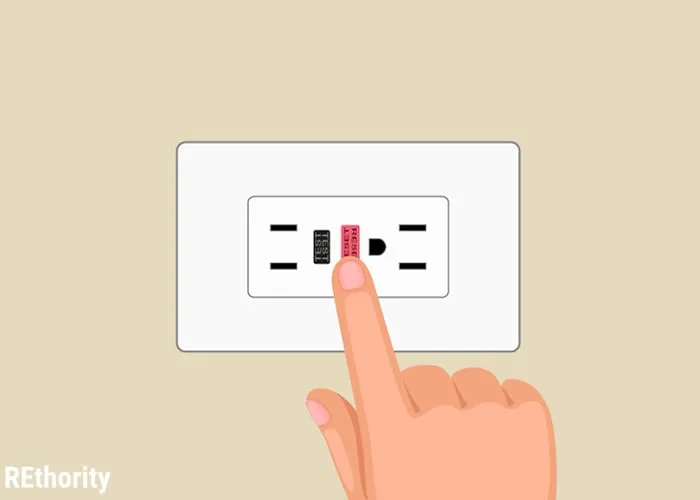
GFCI outlets are easy to reset. They feature a button made just for this purpose. Simply unplug any devices that are plugged into the GFCI outlet and press the reset button.
Plugging a device into the outlet will show you whether or not resetting it worked. Alternatively, you can try resetting the GFCI breaker switch located at your circuit breaker. It should be labeled.
If you cannot reset the GFCI outlet this way, contact a licensed electrician to inspect and troubleshoot the problem.
GFCI Outlet Cost
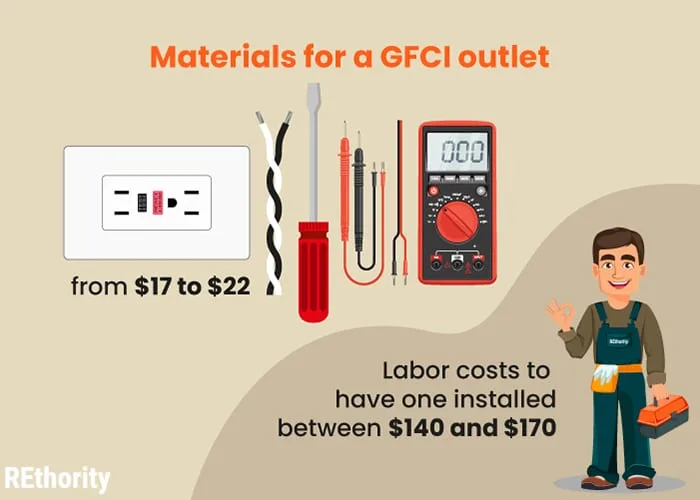
The average GFCI outlet cost is generally pretty inexpensive. You can expect to pay about $20 for the receptacle itself, but the range is about $17 to $22.
If you hire a licensed electrician to install a GFCI outlet for you, the cost rises a bit due to labor costs. On average, you can expect to pay anywhere from $140 to about $170 for installation, with the nationwide average cost being $154.
You may pay less or more depending on your area, the number of outlets you need installed, and more.
Even though hiring a licensed electrician to install a GFCI outlet for you increases the cost, it’s more than worth it if you’re not an experienced electrician.
It’s easy to make potentially fatal or damaging mistakes when working with wiring and circuitry in your home. Don’t take a risk and do it yourself if you’re not sure you’re qualified.
Leave it to a professional, so you’ll know your home’s wiring is safe and up to code.
Final Thoughts on GFCI Outlets
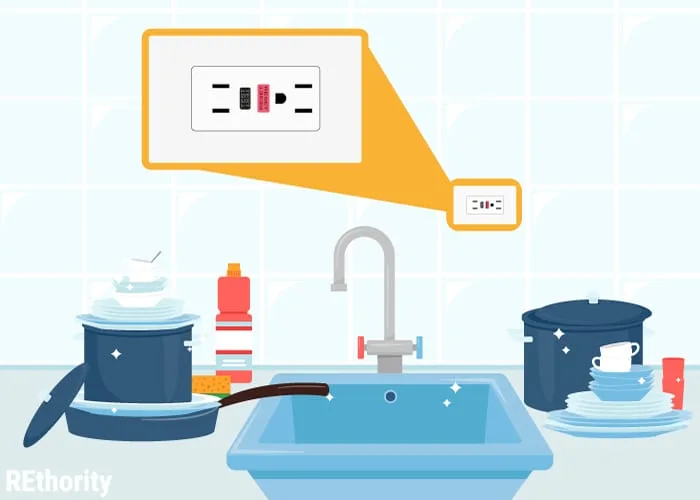
GFCI outlets are essential safety devices in our homes. Without them, small issues that aren’t yet powerful enough to trigger the circuit breaker to trip can cause serious injuries, fires, or even fatalities.
With GFCI outlet rules and code requirements changing about every three years, it’s smart to keep up with the current requirements to ensure your home is at its safest.
You know that GFCI outlets are required in bathrooms, laundry rooms, and kitchens. But you may not have realized that in recent years, the rules have changed to now require them in both finished and unfinished basements.
Anywhere Near Water
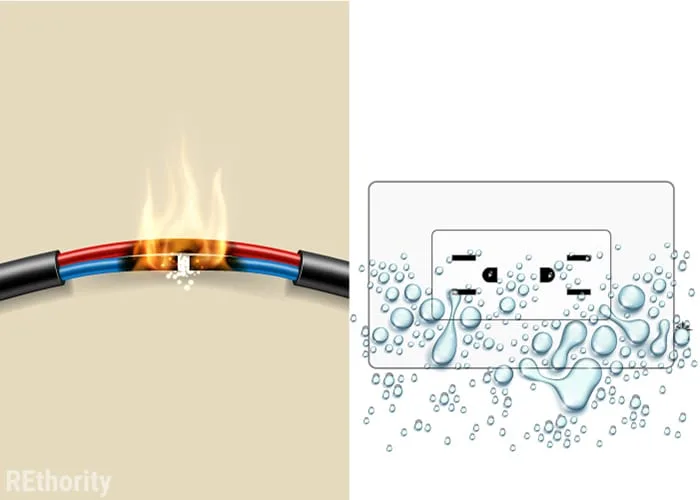
Anywhere that dampness or water could be a potential issue, you need a GFCI outlet. Get familiar with the GFCI outlets in your home. See how many you have, and get used to using the test and reset buttons.
Now that you understand what these safety devices are for, you can feel confident and comfortable when you plug a device into them.
And if one of your GFCI outlets trips, you’ll know how to approach the problem safely. Above all, don’t forget to rely on a licensed electrician for any problem or installation of a GFCI outlet.
They’ll safely do the job and ensure it meets all code requirements nationally and locally.

